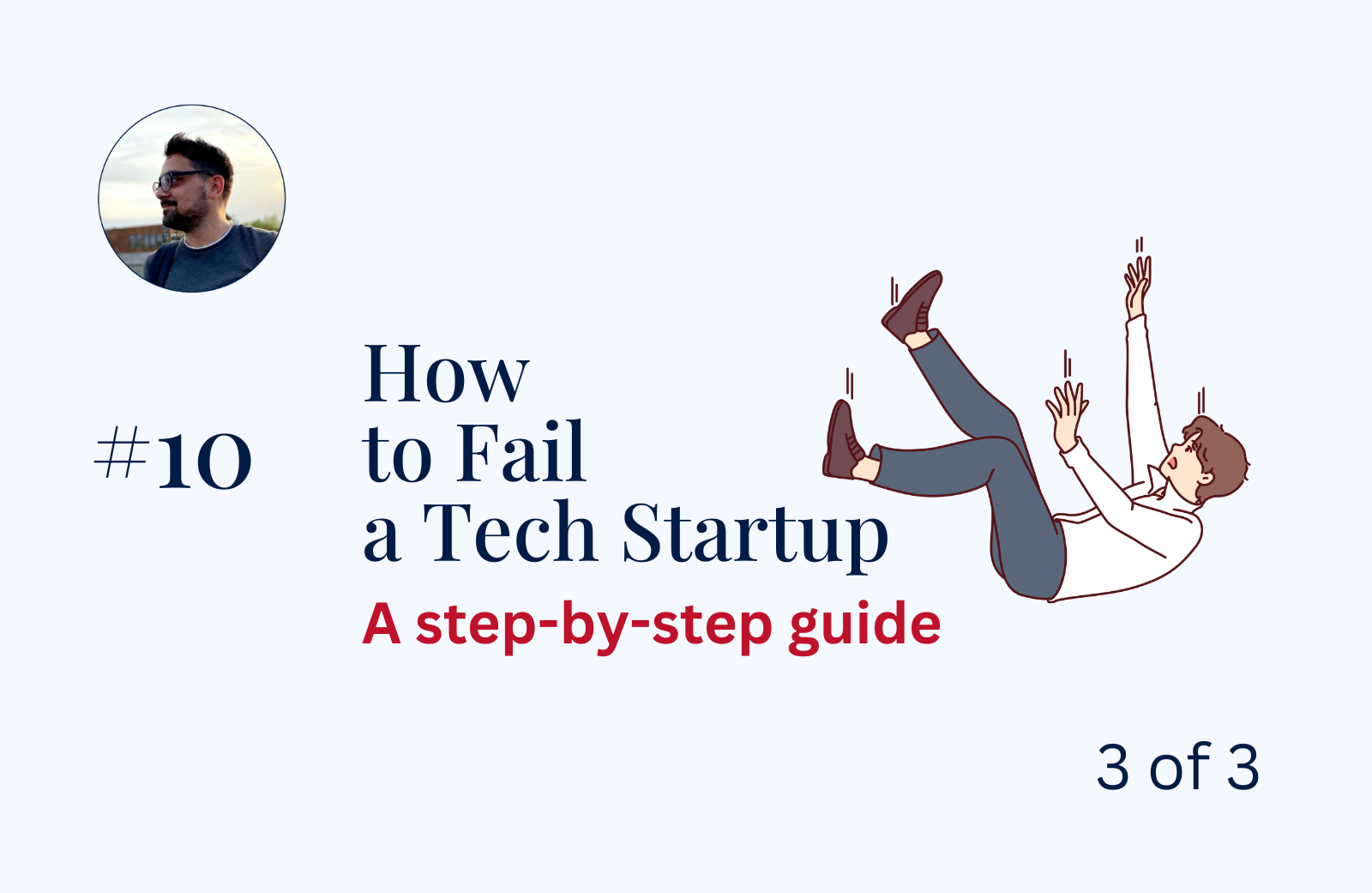
19 Jun How to Fail a Tech Startup: A Step-by-Step Guide – Part 3 of 3
Jun 19, 2024
This publication is the continuation of “How to Fail a Tech Startup: A Step-by-Step Guide – Part 2 of 3”. If you missed Part 2, you can catch up here.
Stage VII – Just One More Feature
The development of the platform was completed, I deployed it and it became available on the market, but I didn’t see any interest from users. How could they be interested if they didn’t even know about it? More on that later.
We have to take into account that I had the mindset of a developer, not an entrepreneur or a salesperson. Therefore, I falsely concluded that the lack of interest was due to something missing in the platform, and that I needed to develop it. I thought, once I develop and release it, everything will be fine.
That mind trap is typical for engineers.
I came up with the following idea: What if I implement a feature allowing users to publish not just campaigns asking for assets but also ideas? Imagine you’re the user. You don’t want to publish a campaign, but you’d like to share an idea you have in mind. That idea is published on the platform, and people can join to start a discussion, similar to a forum. If the idea grows and becomes popular, it might be converted into a real campaign. Think of the ideas as undeveloped campaigns that need clarification before becoming full-fledged campaigns.
We developed and released that feature as well, and guess what – nothing changed!

This is a devil’s trap for money, hopes, and time.
If you want to fail:
- When you release your product on the market and nobody seems to be interested, adding more services or improving the old ones just because you believe it might make a difference, without actually analysing what went wrong, is hardly the best approach to lose more money and time.
The real lesson here is:
- If you feel even the slightest temptation to add a new feature, stop and think. Am I making this decision with the mindset of an entrepreneur because I see a market opportunity, or am I fooling myself?
Stage VIII – Registering a company
If you’ve followed me closely throughout my journey, you might have noticed that I was quite serious about my startup.
I believed that if I were to meet potential investors in the UK, I must have a company registered there. So, I did just that.
I used the services of a UK-based company to register my own – Peoplegogo Ltd. The process was straightforward and simple.
The real lesson here is:
- There aren’t any lessons here. Registering a company and presenting your startup as a legal entity is a must when engaging with investors.
Stage IX – Where Are the Users?
So, where are the users? I told all my friends, I shared it on social media, I had budget for advertising, and I met with a few investors for casual conversations about the platform.
Here is a very short video that was used as an advertisement on YouTube. I hired a lady from the UK to provide the voiceover.

I went to London and stayed there for a month. I visited the Google Start-up Factory, attended various events, spoke with people there, and exchanged business cards. The result I got was — nothing.
Nobody was genuinely interested.
The only traffic on the website was from my friends, who would visit and then leave quickly. If I asked them if they liked the idea, they would say “Yes” out of courtesy.
If you want to fail:
- When talking about validation, rely solely on the opinion of close people like friends and relatives. This is the shortest path to get mislead about the real value you provide.
The real lesson here is:
- Your friends and your mom don’t care about your business. The only true validation you can receive is from real customers who recognise you as someone solving a problem they have. Everything else is just dust in the eyes!
Stage X – The illusion
The whole experience was quite discouraging. I had spent so much time, energy, and money, and it didn’t work. Why? I thought to myself: The platform is a great idea, but just nobody is showing interest.
Back then, I didn’t realise how right I was. Yes, the platform is a great idea, but indeed, nobody is interested! Do you see the obvious truth here? Nobody is interested. There’s a saying: If something sounds like an elephant, walks like an elephant, and smells like an elephant, it’s most probably an elephant.
And then came the next trap. When you’ve invested a lot of time and effort into something, it becomes very difficult to let go, regardless of whether it’s right or wrong. I was too attached and I didn’t want to accept the fact that it was a failure. That was the moment when I created an illusion in my head — that the project was great and one day it would be successful. I fed this illusion for a while.
Speaking of illusions, consider checking out the book ‘Project Management’ published by Harvard Business Review. In one of its chapters, the author discusses a common mistake made by project managers – they fail to end projects that they’re working on, even if no one else is interested, because they’re too attached to them.
If you want to fail:
- Establish a strong emotional connection with your business, which later might prevent you from letting it go when things start heading in the wrong direction.
The real lesson here is:
- In business, there’s no room for emotions. If something is not generating revenue, simply abandon it.
Stage XI – Admitting That I’ve Failed
Months later, I had to admit the obvious truth — I had failed.
There is nothing more to add to this chapter; the entire project was a failure… Almost.
Was It All For Nothing?
No, it wasn’t. It was actually one of the best lessons, costing me nearly £10,000 and 12 months of hard study and work. Here are the lessons I learned.
Lessons

Before you start:
- Believing too much in an idea and being too emotional can make you “blind,” stopping you from evaluating the situation objectively.
- If you cannot formulate a crystal clear one-sentence pitch, that means you don’t truly understand your business and what you are doing.
- If you are the one building the product, make sure you have a salesperson on board first. You can create the best product, but if there’s no one to sell it, you’re just wasting your time.
Monetisation:
- If the product does not make money, you are doing something wrong. Altruism is a good concept, but at the end of the day, people are interested in what they will get in exchange for what they give. This is how human nature works.
Efforts:
- Don’t write overly long business plans. You can use “Business Plan Canvas”.
- Simplicity is key. People need a simple solution to their problems; they don’t need complexity.
- Do not use fancy technologies just because they are trendy. You might be an engineer but when you build a product you must be an entrepreneur. Your goal is not to be modern, your goal is to solve a problem and sometimes the simplest tools are the best.
- Do not overcomplicate the development process. Release as soon as possible a version that can test the market. Improve later.
- If you feel even the slightest temptation to add a new feature, stop and think. Am I making this decision with the mindset of an entrepreneur because I see a market opportunity, or am I fooling myself?
- After reading about my entire journey, you’ve probably noticed that there were many business and technical aspects that I overcomplicated. This was primarily because I was trying to solve problems I didn’t have. So, here’s the lesson: Do not solve problems you don’t have.
Validation:
- Your friends and your mom don’t care about your business. The only true validation you can receive is from real customers who recognise you as someone solving a problem they have. Everything else is just dust in the eyes!
- If you develop a good product and you have the right sales person but the market is not responding for a long period of time, do not hesitate, kill the product – life is one and it’s not a joke, don’t waste it.
Mindset:
- I am going to say something that contradicts much of what we hear about starting a business. People say it’s exciting and emotional, etc. But I will suggest the following: if it’s too exciting, you’re doing it wrong. Business should be pleasant, but it should also be a bit boring. Boring means that you are so clear with each piece of the puzzle that you know what to expect.
- Do you know what the most valuable thing you learn at school and college is? Sure, it’s what the teachers teach you, but there’s something else as well: building a network of professionals in their areas who can be of help later — in other words, connections. Building a business without connections and not knowing the right people is like going to a hospital without doctors. Being charismatic, funny, and having soft skills are essential in business. This is the harsh reality. Use your personal advantages and improve them. If you are tall, know that this can help you because people tend to like tall people. If you’re a good storyteller and you can entertain people, use that skill. Whatever advantage you have, develop it, use it.
-
Tips for Those Who Want to Run a Startup
If you want to start a startup business and you lack experience, here is a concise list of steps to follow:

- The first and most crucial question you need to answer is, who are you? Do you possess soft skills, or are you more of an engineering type? If you’re an engineer without soft skills, you must find a person who would like to join your journey — someone who possesses soft skills and has a network of connections. Conversely, if you are the person with soft skills but you’re not a skilled engineer, find one.
- Once you know who you are, what your role is, and you have the right team, be crystal clear with yourself about the business idea. Do I understand my business, and is it going to be profitable? Avoid the trap of thinking that you have all the answers. Most likely, you don’t. Instead, go outside and talk to people. You may think: “But they might steal my idea.” Well, let me dispel that concern. Most people are lazy, and it’s highly unlikely they would take the initiative to steal your business idea. End of conversation. Just talk to them and gauge their thoughts on your business. However, when you speak with them, do not “prime” them. Present the idea of your business without asking whether they think it’s good or bad. Simply observe their reactions.
- Once you know your role, understand your business, and are confident it can generate revenue, start building it. Don’t overcomplicate things. Overcomplicating can lead to the risk of losing money, wasting time, and getting stressed.
- Test the market with a simple version of your business. If the market doesn’t respond, be prepared to shut down the business. If there is a response, then continue to develop and expand.
